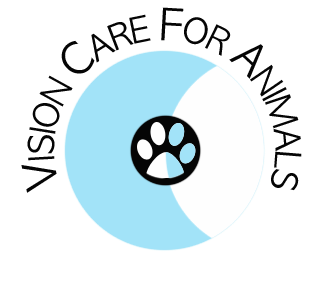Did you know that animals can develop nearly all the same eye conditions that humans do? Examination of veterinary patients starts with evaluation of vision and reflexes. Then using specialized equipment (slit lamp biomicroscope & ophthalmoscope) to look at the front and back of the eye respectively, each structure is evaluated for health. The following is a list of common eye conditions that cause ocular pain and can lead to loss of the eye or even complete blindness. Fortunately, with early diagnosis and therapy many conditions can be resolved or managed with preservation of vision and restoration of comfort.
#1 Corneal Abrasion / Ulcer
Accounts for the greatest number of visits to the veterinary ophthalmologist. Ulcers are very painful and can rapidly place the patient at risk for significant vision impairment or even loss of the eye.
#2 Dry Eye Syndrome - including qualitative tear deficiency
Can occur in any breed. At risk breeds include Shih Tzu, Bulldog, Cocker Spaniel, Pug, Lhasa Apso, West Highland Terrier. Newer medications that target and treat the underlying cause of tear deficiency are key to preserving tear function. This is one of the most rewarding conditions to treat as patient quality of life can be significantly improved.
#3 Lens Disease - cataract or luxation
Most people understand cataract interferes with vision; however most do not realize cataracts often lead to inflammation within the eye placing the individual at risk for retinal disease and/ or painful glaucoma. Therefore early evaluation and intervention is necessary.
#4 Uveitis - internal inflammation of the eye
Symptoms can be subtle redness and easily confused with allergy. However if unrecognized and untreated this disease leads to vision impairment and blindness. Depending on the underlying cause patients can do very well with early diagnosis and treatment (lifelong therapy can be necessary).
#5 Eyelid - inherited abnormalities, abnormal eyelashes, tumors, inflammation
Traditional surgery, laser and cryotherapy is the treatment of choice to resolve most eyelid diseases.
#6 Tumors inside the eye
These can be benign or malignant. Fortunately most tumors originating from inside the eye can be cured with eye removal (enucleation surgery). Contrary to popular belief the surgery results in rapid healing and is almost painless.
#7 Glaucoma - elevated eye pressure
One the most difficult and rapidly blinding diseases we treat. Fortunately, newer topical therapies (eye drops) can help postpone the inevitable loss of vision. Surgery (valve and/or laser procedures) can preserve vision for even longer.
#8 Trauma
Prevent puppies from harassing your cat! Cat claws and corneas are a bad combination. Bites to the eye and face are typically the result of dogs fighting over food, toys or to establish social dominance. Fortunately we have the ability to repair many traumas (including eyelid, cornea and lens) using advanced surgical techniques.
#9 Systemic Disease - including high blood pressure, autoimmune disease, cancers
They say the eye is the “window” into the soul. From a health perspective the eye provides health professionals the unique chance of early detection and treatment of a variety of conditions that affect the entire patient.
#10 Infection
Whether treatment consists of eye drops, ointments and/or oral antibiotics the full course of therapy prescribed should be completed in order to reduce the chance of bacterial drug resistance.




